Pegmatites: Earth’s Most Amazing Rocks by Dr. Michael Wise, Smithsonian Institution
Synopsis by Andy Thompson, MSDC Secretary
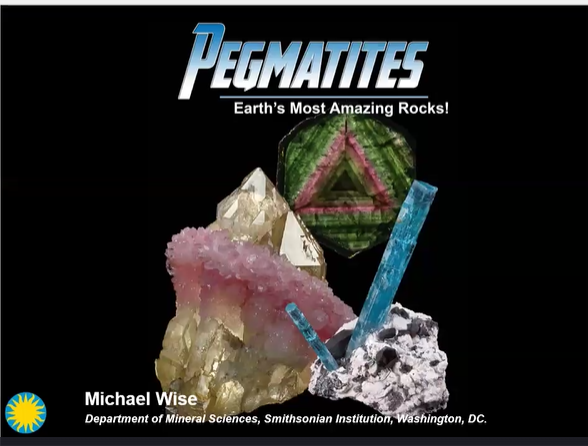
The purpose of this synopsis is to provide readers with highlights from Dr. Michael Wise’s presentation as encouragement for readers t0 visit MSDC’s YouTube channel and view his presentation in its entirety. You can find Mike’s entire 58-minute talk on YouTube here.
“Tonight, I am hoping to convince everyone that pegmatites are the most exciting and the best rocks on the planet.”
Dr. Wise continued: “I want to share with you some of the little quirks that you might not be aware of, and sort of give you a very simplified version and understanding of how some of us think these pegmatites form.”
Pegmatites Contrasted with Other Rocks

Mike explained that most of the familiar types of rocks have a fine-grained texture. They are simple in that within each of their categories, such as for the six shown above, there is not much variation. “Frankly, compared with pegmatites, they are kind of boring.”
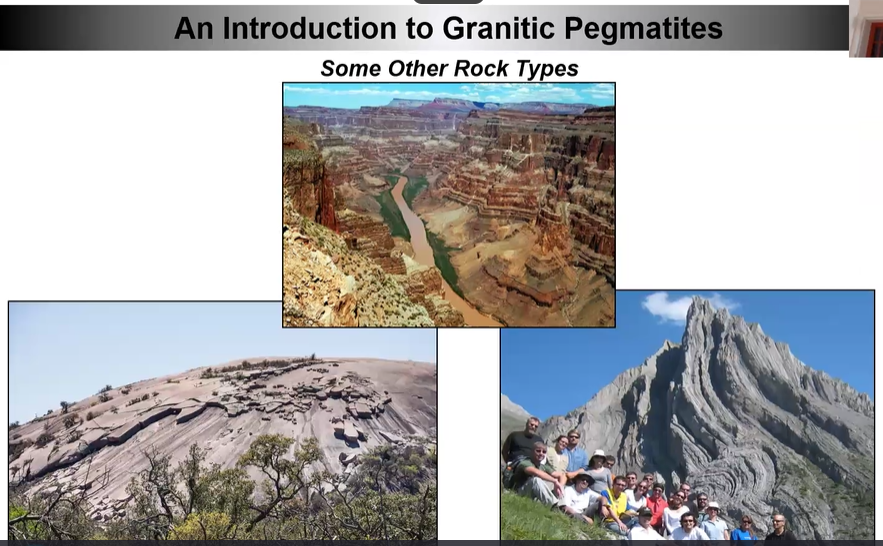
He contrasted pegmatites with the mineralogically simple rocks commonly found in large geological structures. Examples shown above, in the top photo and moving clockwise:
1) the Grand Canyon with its sandstone, limestone and shales,
2) the metamorphic rocks which show the deformations and changes in the Earth’s crust, and
3) on the bottom left, the large rock formations of granite plutons and batholiths.
Pegmatite’s Etymology and Crystal Form
The name “pegmatite” originated in the 1800s and derived from its appearance of interlocking gray granite and white feldspar crystals, as shown below. The early geologists saw that pegmatite crystals looked like the closely written wedges of ancient cuneiform tablets. So, Mike said, they named the crystals after the Greek word pegnymi, which means “to bind together.”
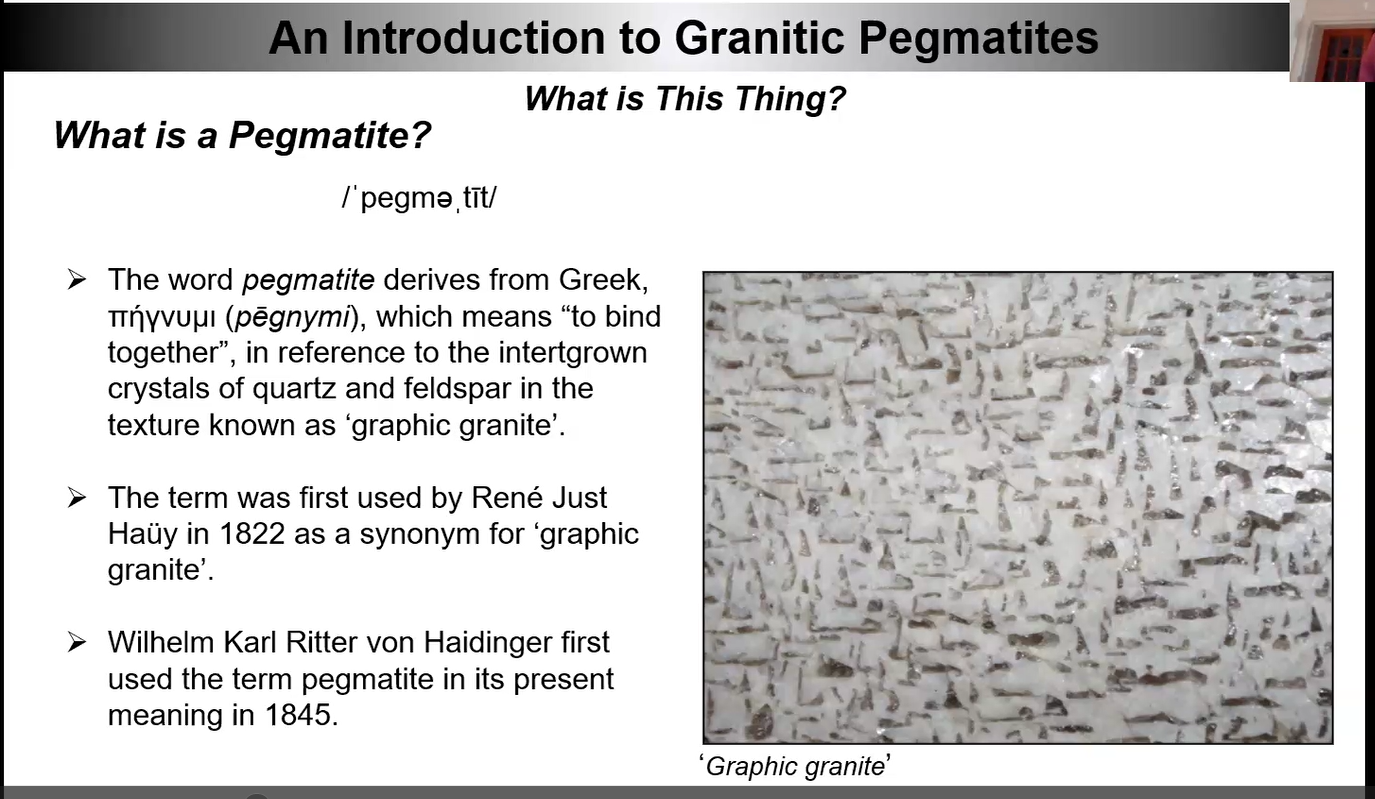
The term “pegmatite” was first used by the French mineralogist Rene Just Hauy in 1822. In his mind and world at the time, it was a synonym for the texture of graphic granite, which is not how the term is used today. A few decades later Wilhelm von Haidinger used “pegmatite” in its current understanding as a rock with abnormally large crystals.
Mike further clarified that today, strictly speaking, pegmatite is a technical term. It refers to the texture of the rock whose crystals are igneous minerals, coarse grained, and, comparatively speaking, gigantic in size.
As explained in the slide below, based on their composition, there are many forms of pegmatites. But the variety most commonly found in the Earth’s crust and which Mike and other mineralogists pay most attention to is the type identified as “granitic.”
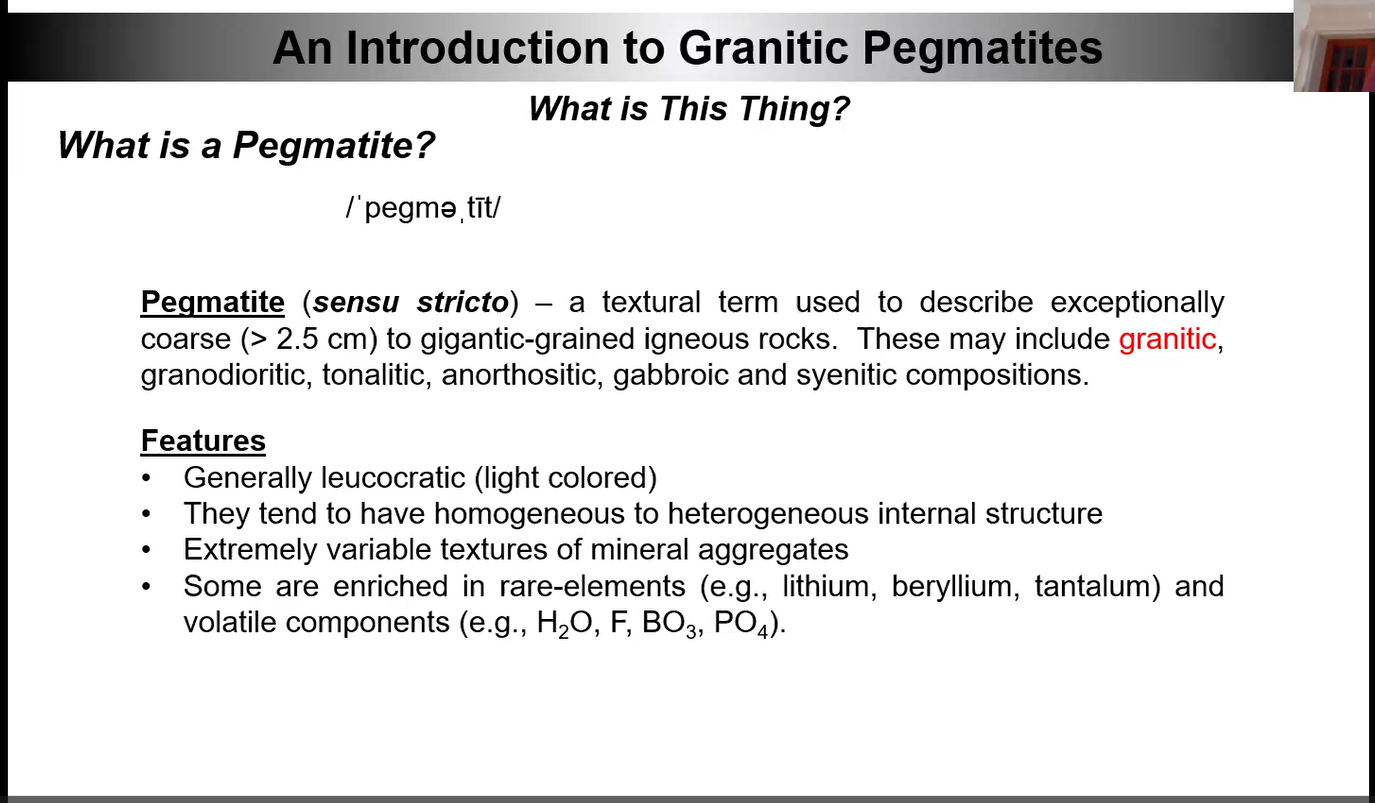
Readers: Why have pegmatite crystals suddenly captured the attention of today’s high-tech industry? As suggested by the slides below, if you want to discover the answer, click on this link to the video of Mike’s presentation.
Hint: Mike’s above slide noted: some are rich in rare-elements (e.g., lithium, beryllium, tantalum) and volatile components (H20, F, BO3, PO4).
Reader: If you want to know what pegmatite crystals typically look like, listen to Mike’s explanation of the slide below to discover white crystals practically the size of the hammer’s head shown at the bottom. Here’s the link.
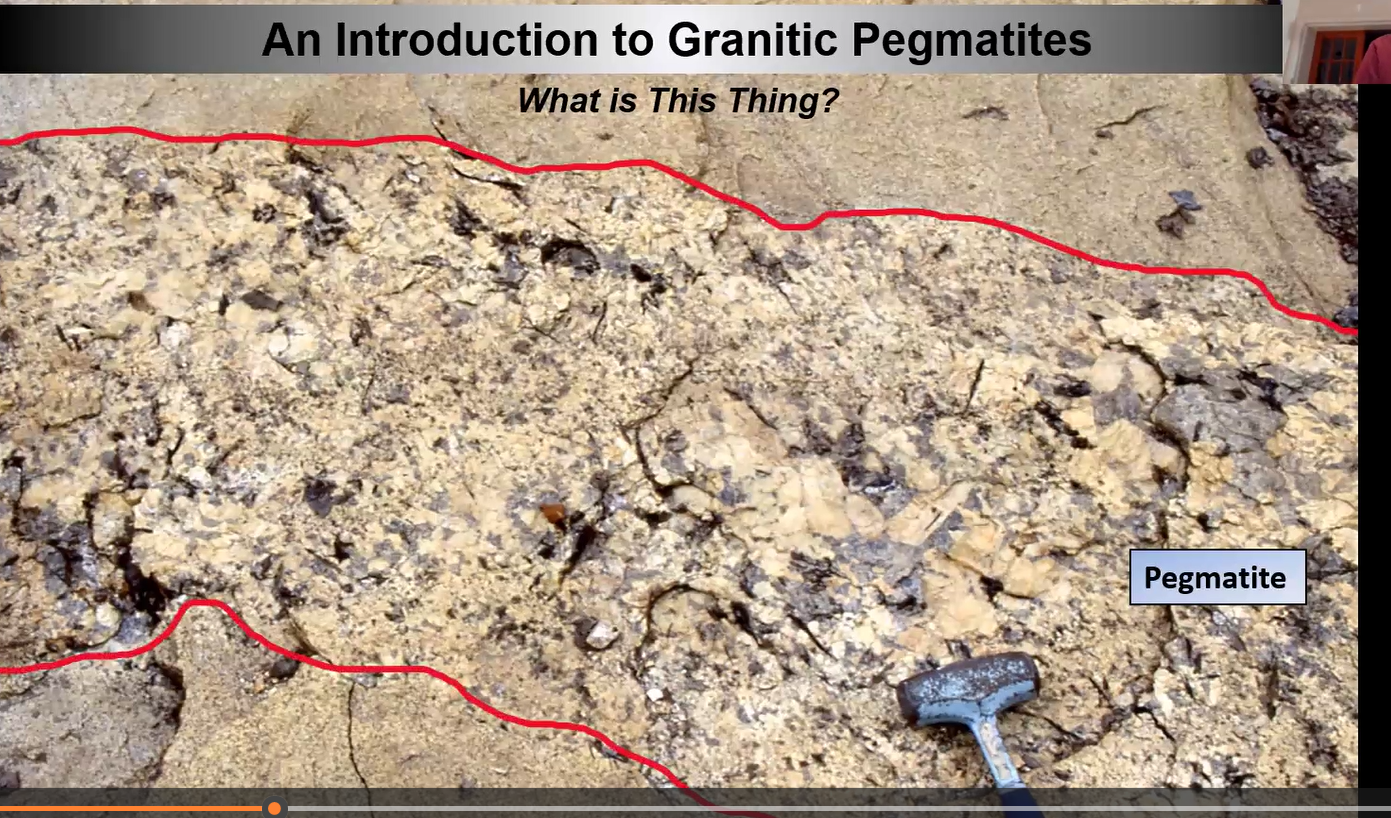
Reader: If you want to see an example of pegmatite that may be your kitchen counter top, and be able to recognize diverse grain sizes typical of pegmatite crystals, as above, view the video.
Hint: “The grain size can be quite variable,” said Mike, and sometimes the “granite” counter top you believed you bought is not actually granite. Know the difference?
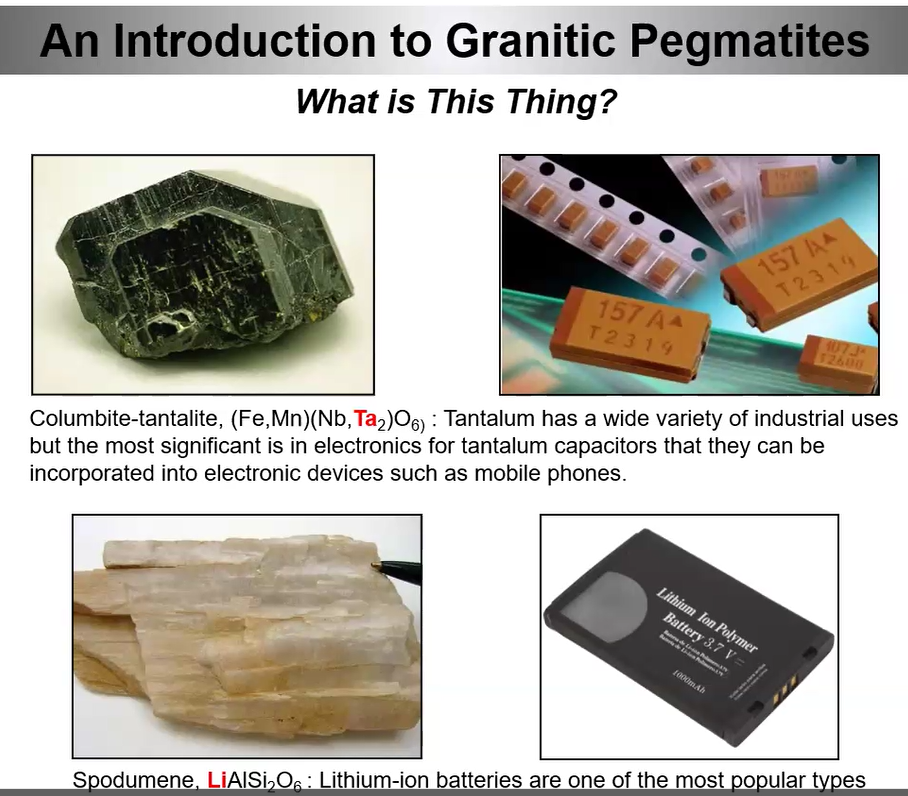
Reader: If you want to know how the formation of pegmatite crystals concentrates rare earth elements as suggested above, and which are in great demand by high-tech industries, view the video.
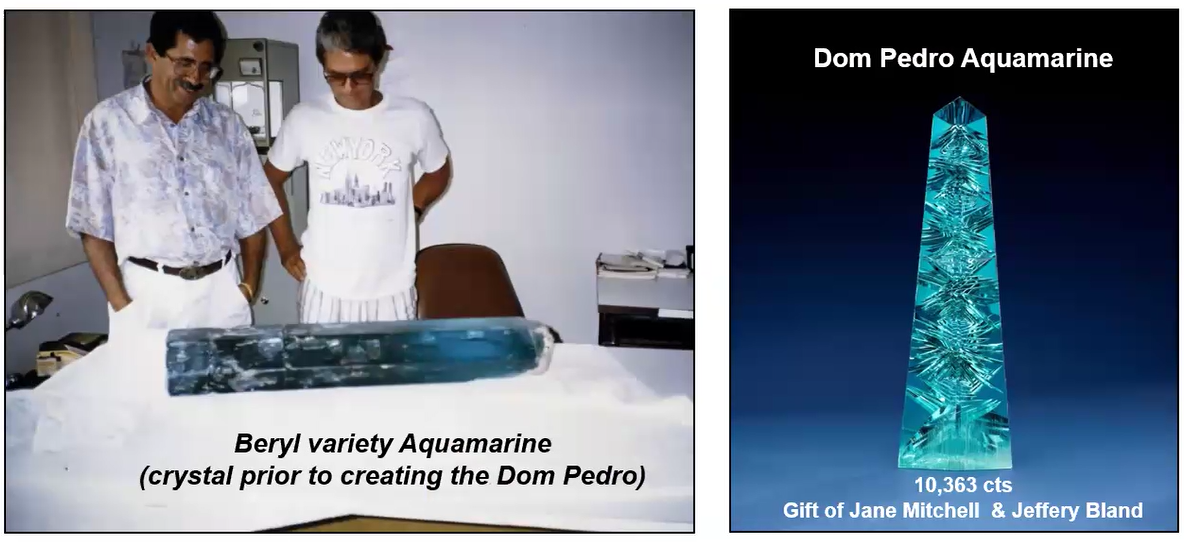
Reader: if you also want to see the significant role pegmatite crystals play for gem collectors, and for museum specimens such as the Dom Pedro Aquamarine at the Smithsonian NMNH, listen to Mike’s explanation.
Readers who want to know what gem minerals are found associated with granitic pegmatite can listen to Mike speak about the gem varieties and colors listed below.
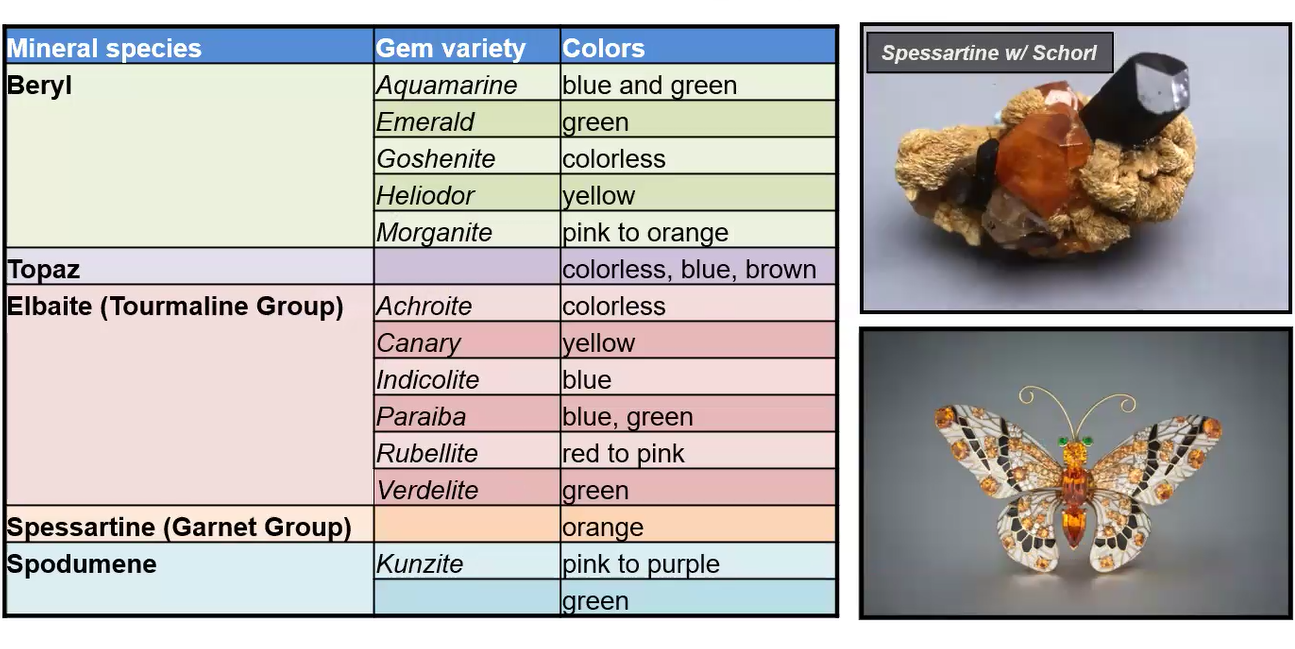
In addition to the more common gemstones listed above, there are also some very rare minerals found within pegmatites that sometimes can be facetted into gemstones, as shown below.
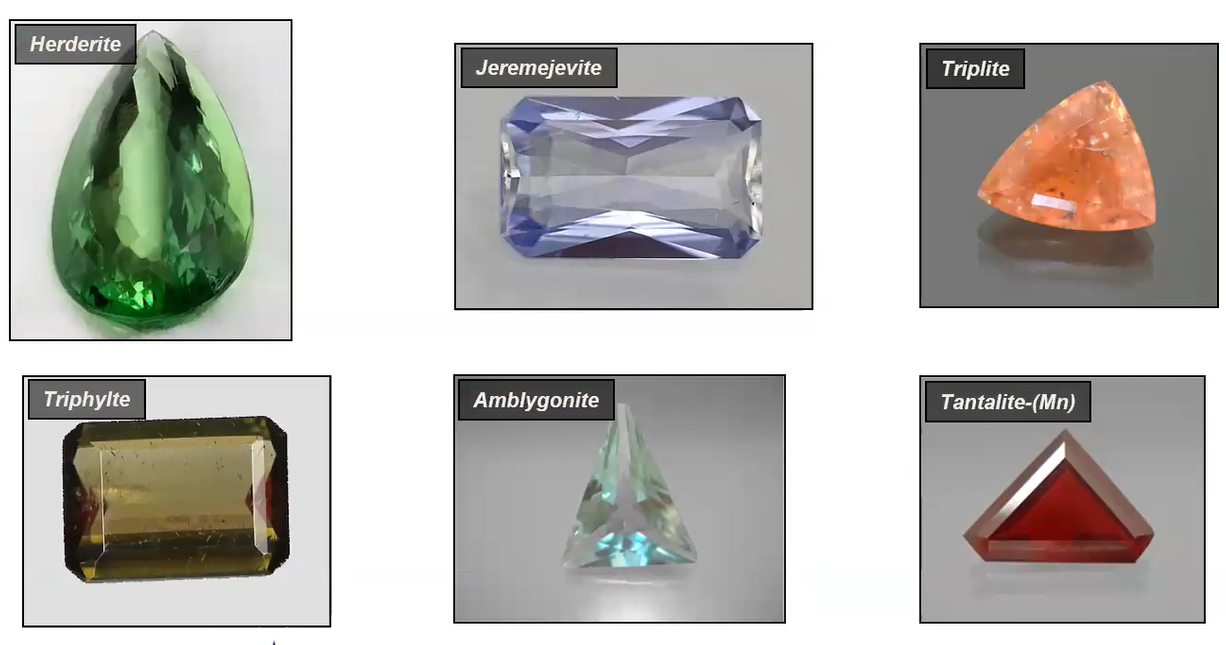
Mike has a surprising message about rare gemstones. With regard to rareness, “people out there who think diamonds are the end all of gemstones need to rethink that.” The above examples are much rarer than diamonds. Want to know what minerals they are made of? Go to the video. 😊
Want to know where pegmatites are found and how they are distributed in the Earth’s crust? Are they even in Antarctica?
Do pegmatites derive from granite and are they found in dikes?
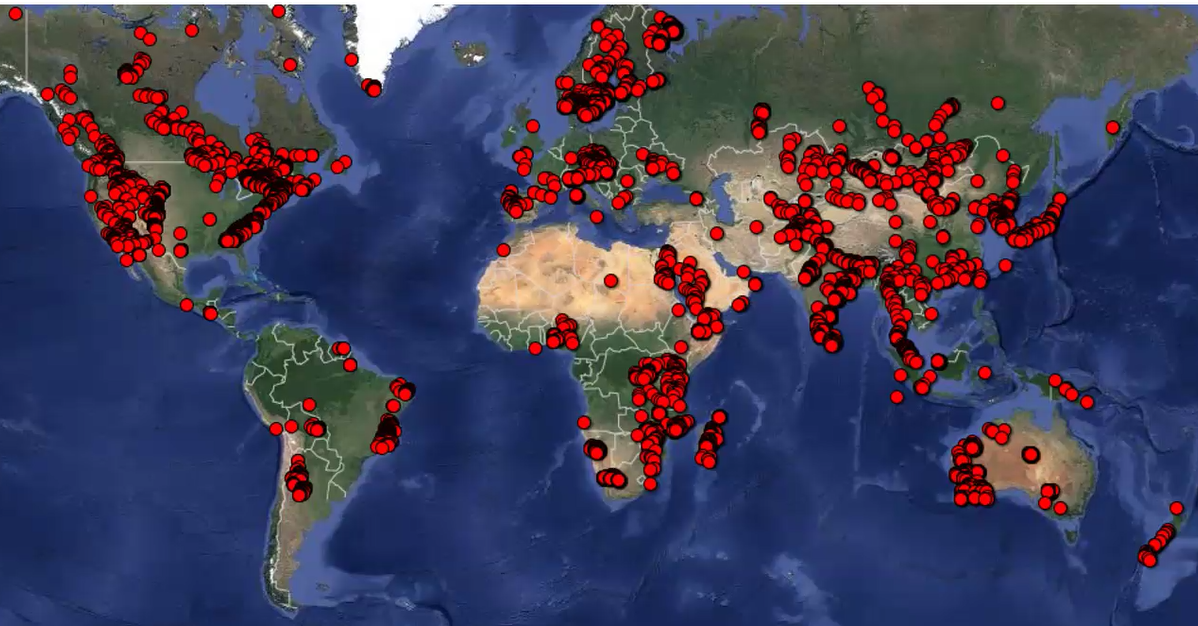
How are Pegmatites Formed?
Mike said that as an introduction to this multi-variable complex process of pegmatite formation, a simplified portrait will suffice.
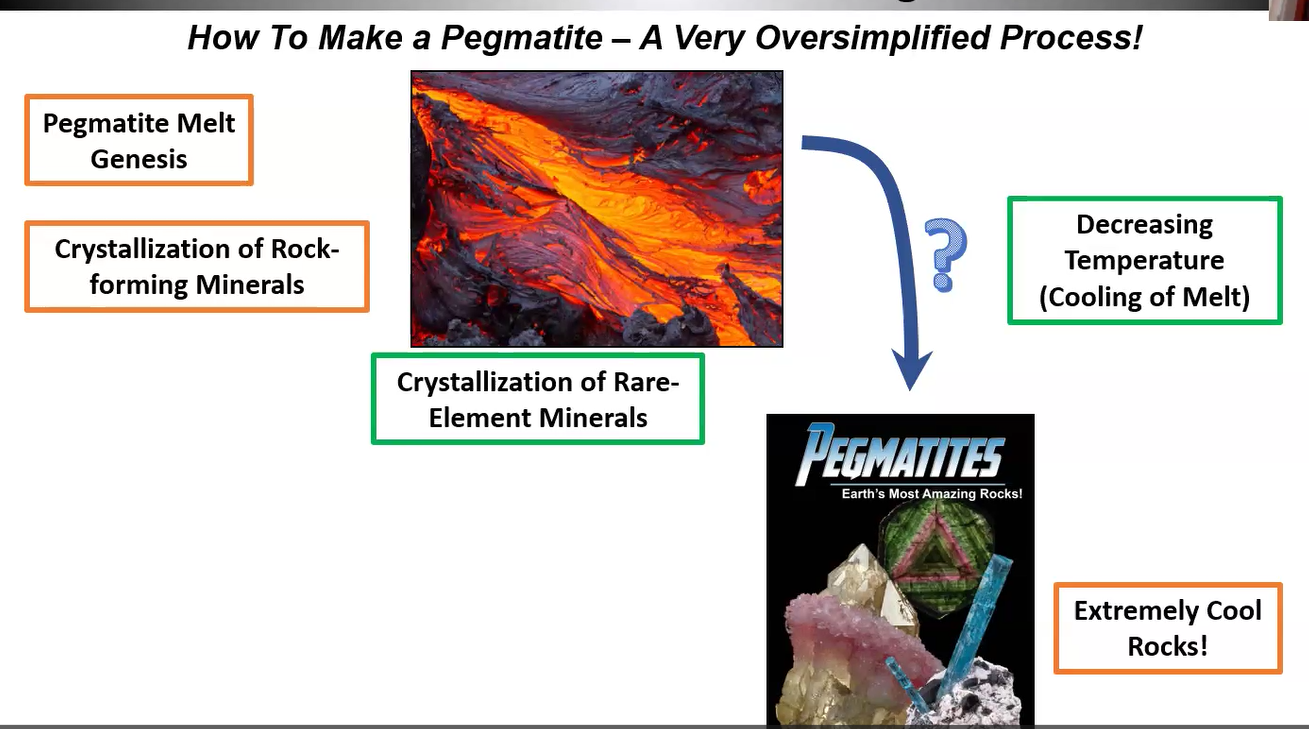
To begin the process “we have to have some molten rock,” which typically is composed of quartz, feldspar, biotite and muscovite granite minerals. But after this commonly agreed upon beginning, geologists belong to one of two camps for models to help explain the genesis of pegmatite.

The two views differ with regard to whether the genesis starts with granite crystallization or with pre-existing metamorphic rock. For a full explanation of the differences, view the video.
An important variable in this genesis is where in the crust the initial magma melt takes place. Mike explained that for generating the granitic pegmatite there are three major settings, two collision zones and one rift zone as shown below.
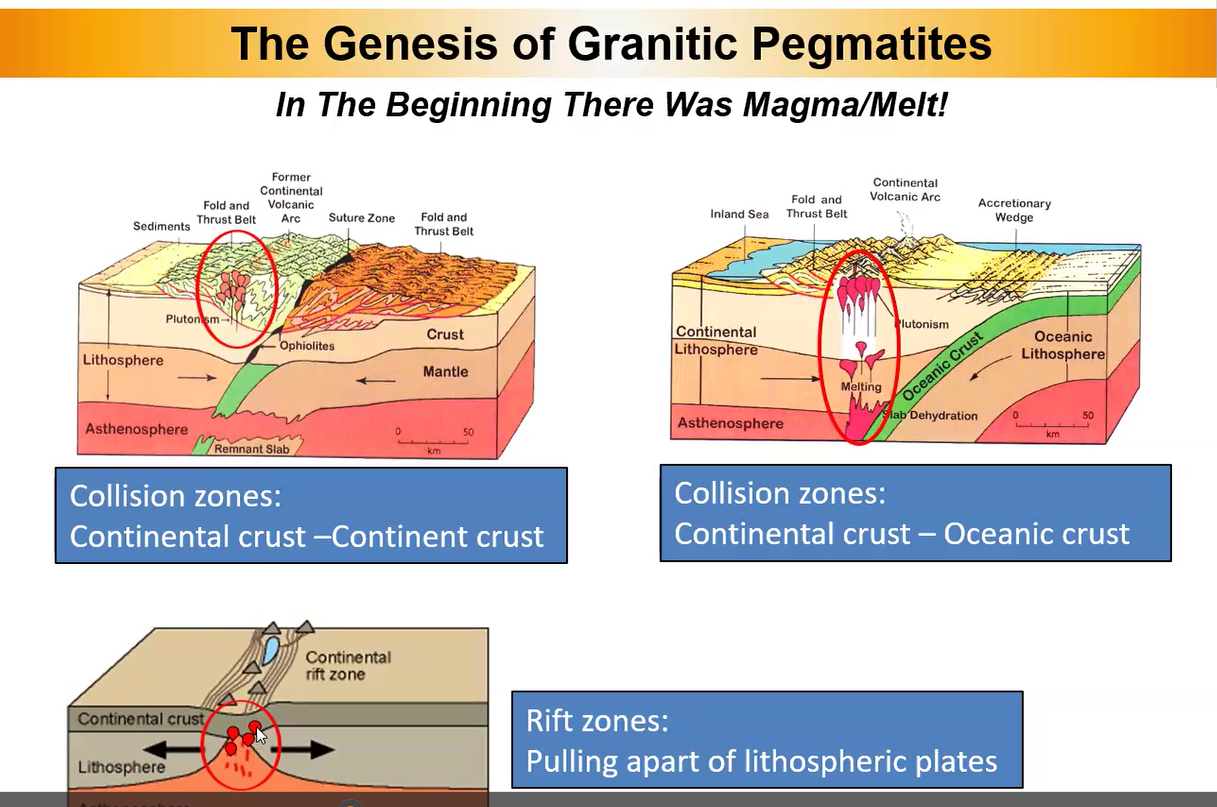
There is evidence, for example, in a small pluton in Rhode Island, that the process of pegmatite formation can be gradual with initially smaller grained crystal formation giving way to the formation of the larger white and dark grains (from top toward bottom), as shown below.
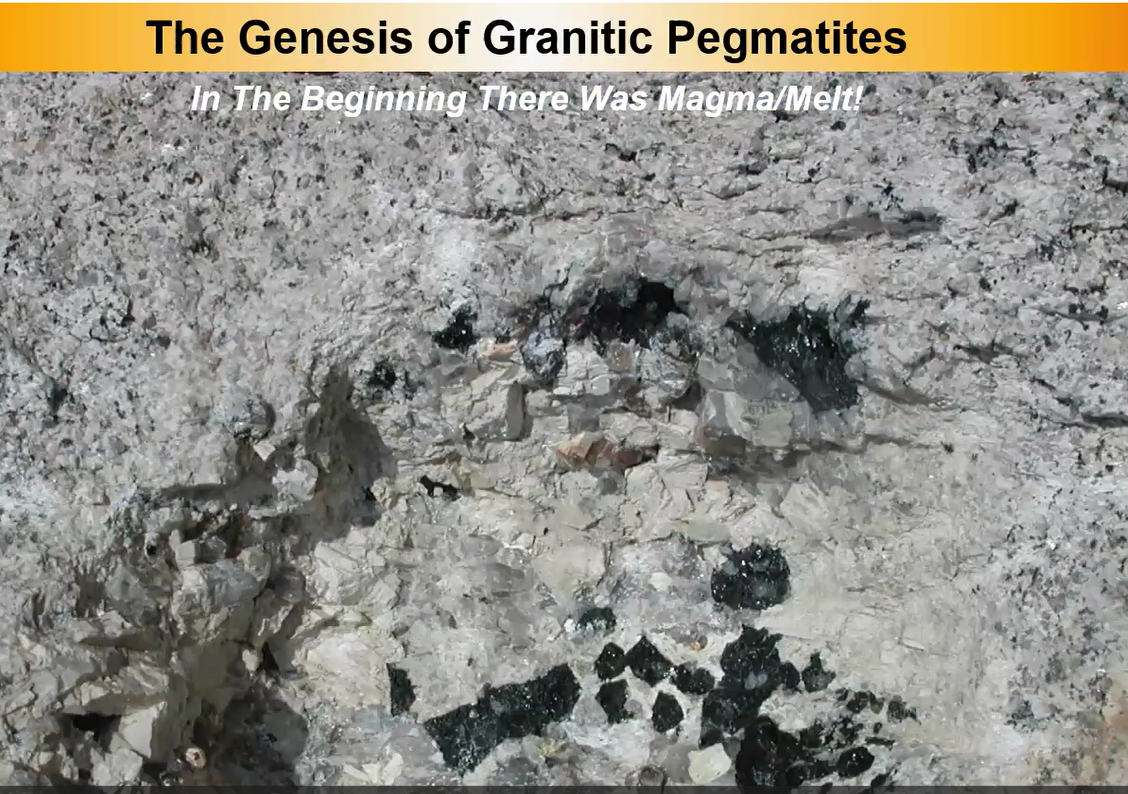
On the other hand, the pegmatite crystals can also form from another process called anatexis, the partial melting and cooling of pre-existing rocks. Mike said he was initially slow to believe that pegmatite minerals could form from the melting of metamorphic rock, until his field research in Denmark. There he became convinced that pegmatite also seems to form from the melting of earlier metamorphic rocks. By studying the rock pictured below, he concluded some of the dark rock remelted and recrystallizing into larger, lighter colored, pegmatite crystals.
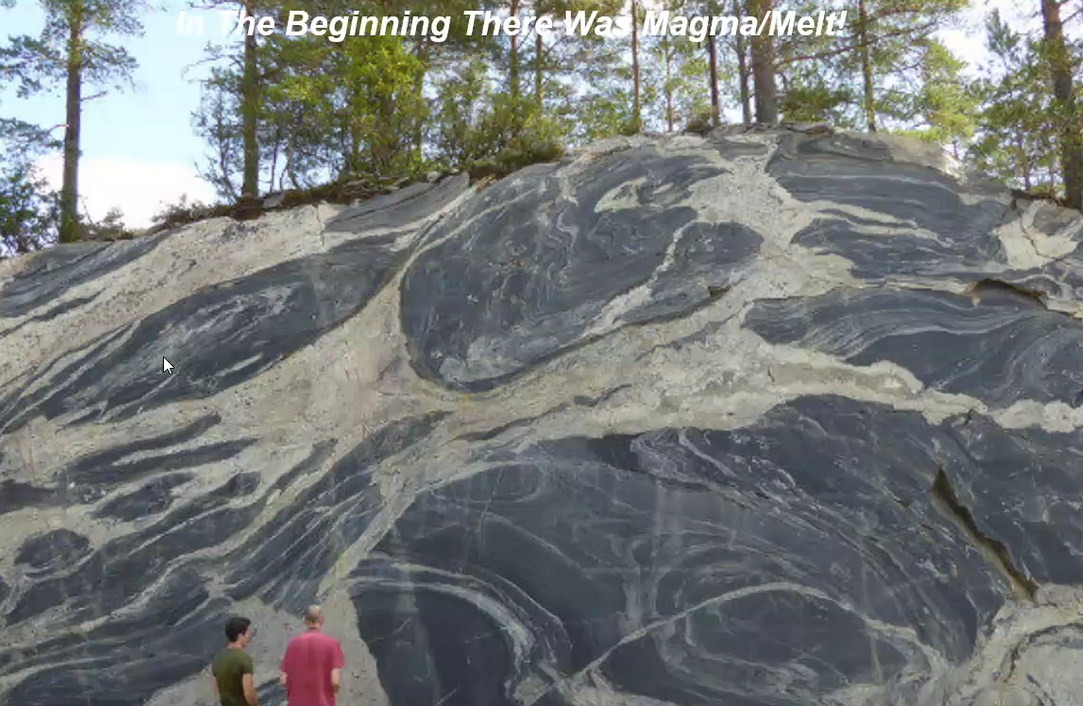
Mike explained what he called an “oversimplified” process of pegmatite formation as sketched below.

The process begins with the melting, described earlier, caused by the collisions of the three zones. That typically happens deeper in the crust. But that raises a question of how the fluid moves within the crust.
Readers: if you want to know how this happens and what mobilizes the pegmatite crystal-laden fluid and moves it higher up into the crust, go to the video. Hint: it has to do with viscosity.
“And Now the Fun Begins,” said Mike
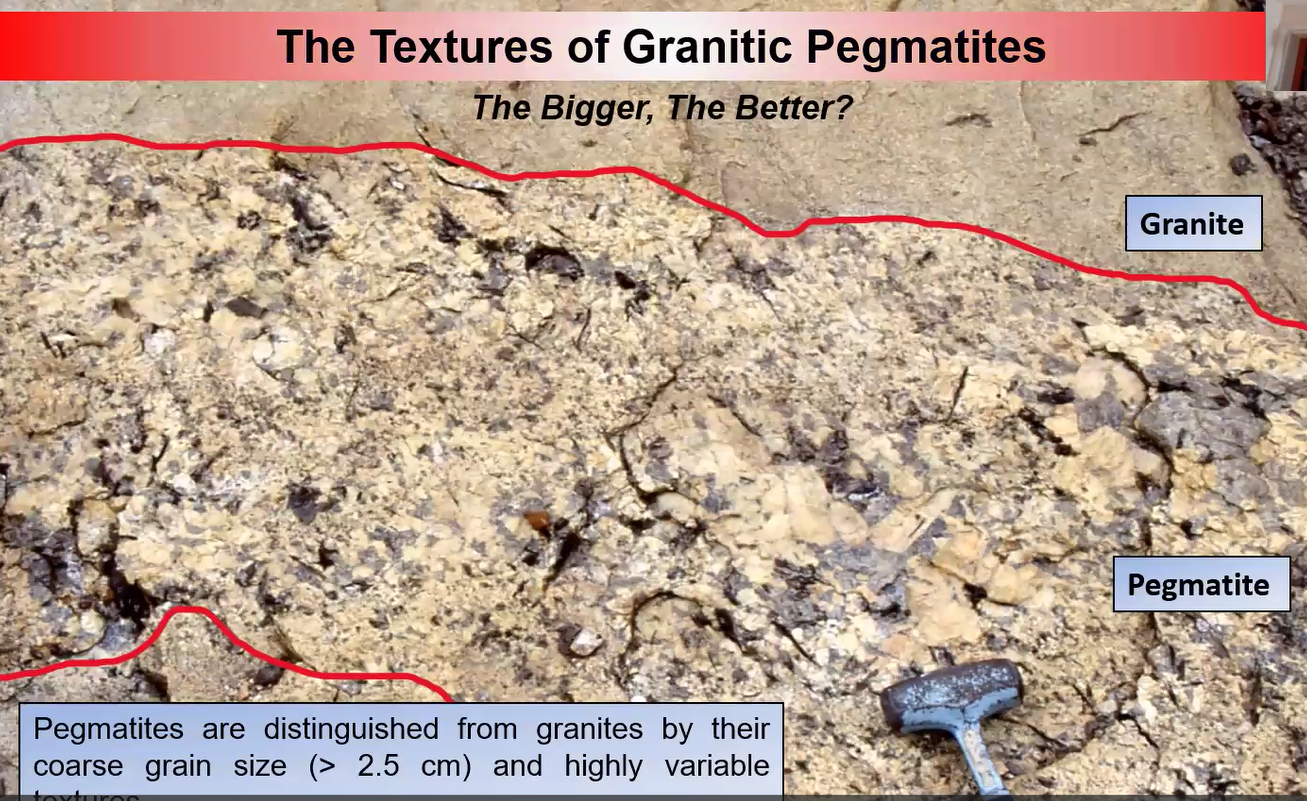
Mike pointed out several important consequences that follow from the melting of the parental granite and the subsequent concentration of the liquid melt. One result is that the growing pegmatite crystals take on a different texture, namely, the crystals become larger. This is the “fun” Mike referred to: large crystals are integral to the definition of pegmatites and “sets them apart from other igneous minerals.” Also, pegmatites have a highly variable texture, or mix of small and large crystals, which is another key characteristic.
When interpreting the above slide showing the gray granite slab on top with its small grain sized crystals, Mike contrasted them with the large white crystals in the middle portion of the slab, an enlarged outtake of which is shown below. He noted that the crystals in the top left corner and its neighboring crystals in that outtake are almost as large as the black hammer head seen at the bottom of the photo. Those large crystals say: we are pegmatites.
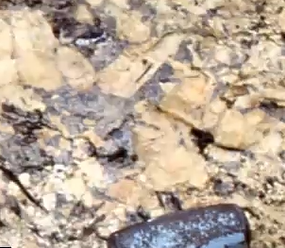
Below, Mike provided more stunning examples of pegmatites on display the Smithsonian’s Mineral Gallery including the twin smoky citrine quartz on the left. On the right is a single twin sulfur crystal that practically filled its pocket in the Himalaya Mine in southern California.
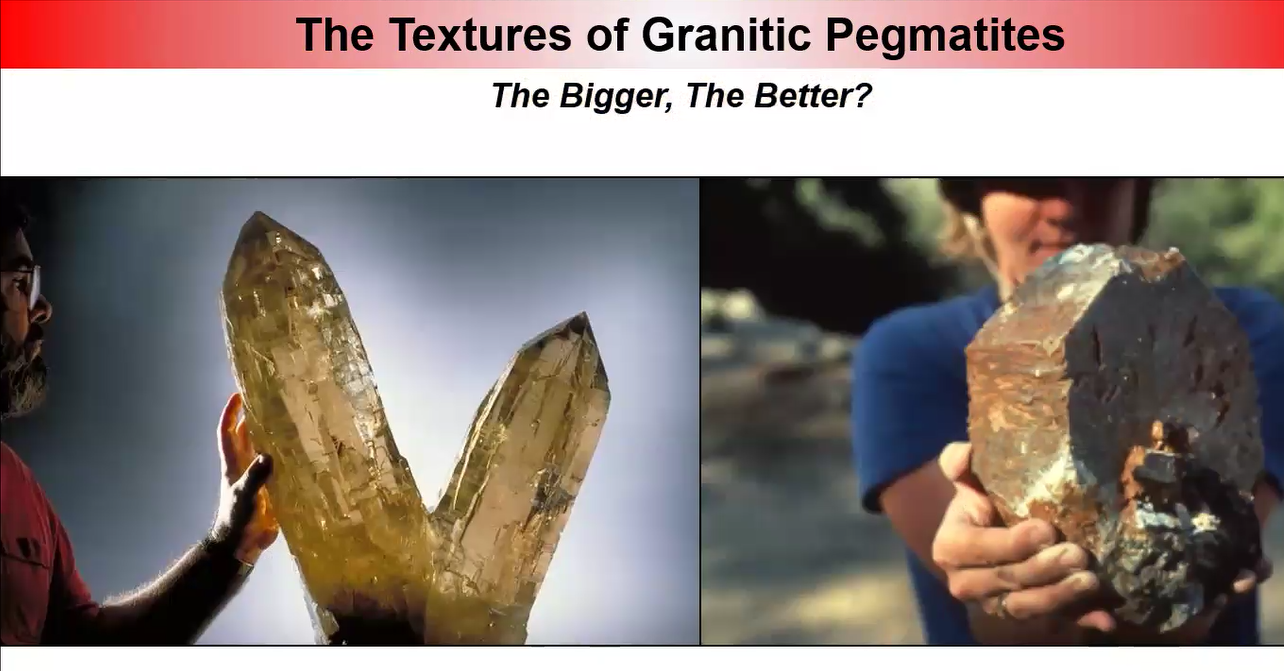
Below are additional examples of seriously large pegmatite crystals, including the famous “Rocket,” an elbaite from Brazil; in the middle is a smoky quartz from Pike’s Peak in Colorado; and on the right is the nearly 20- foot-long microcline crystal from S.E. Manitoba, Canada.
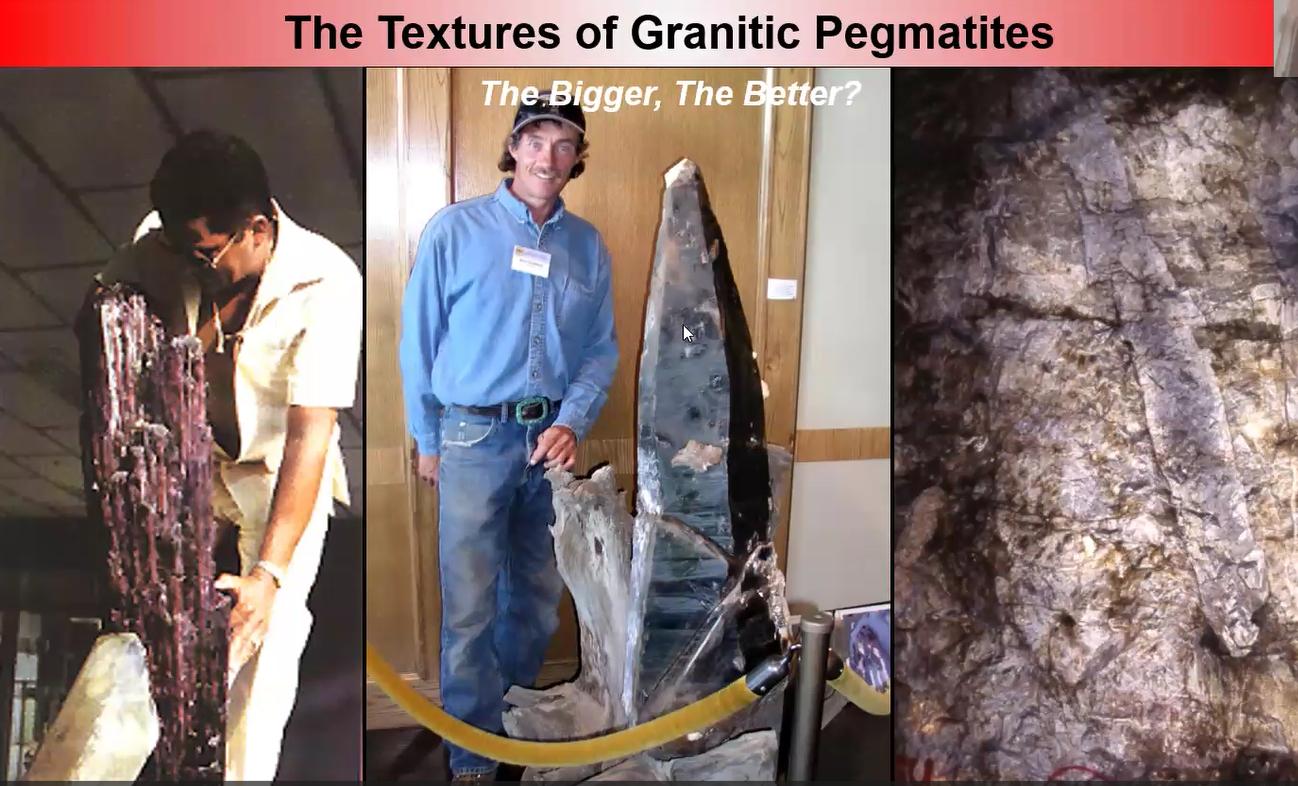
Tiny crystals can also be a hallmark of pegmatite crystals. As a reminder, Mike showed two examples, with, on the left, a fine-grained aplitic granite body from Maine with a penny for comparison. On the right is a fine grained lepidolite from the Steward area in southern CA, with a black camera lens cap for comparison.
Readers who want to learn about how pegmatites occur in both zoned and unzoned formations, and how within the zoned formation the crystal size increases toward the middle, go to the video. Ditto for those wanting to learn about three variations in the pegmatite textures shown below.
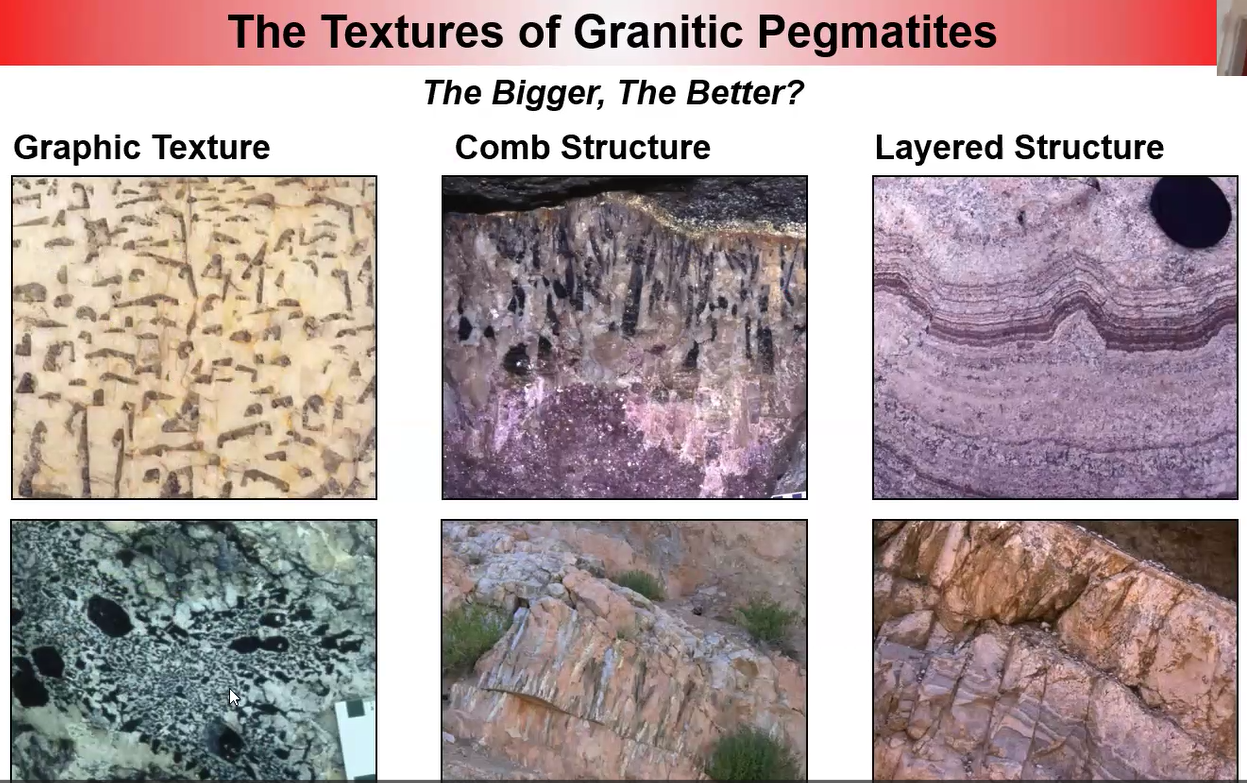
NMNH Mineral Department’s Teamwork
By way of a summary of different textures, Mike showed a photo of a pegmatite wall in the Pala district in southern California which his colleagues, Kathleen Brown, and Tim Rose, helped Mike to research. Mike used the long wall of pegmatite to explain the variations you can find in a single deposit.
Mineralogy of Pegmatites
“It is the mineralogy which really sets pegmatites apart from a lot of other common rocks.” The familiar specimens below are often what gem and mineral collectors pursue. But some collectors do not realize that topaz, quartz, and fluorite are actually pegmatite minerals.
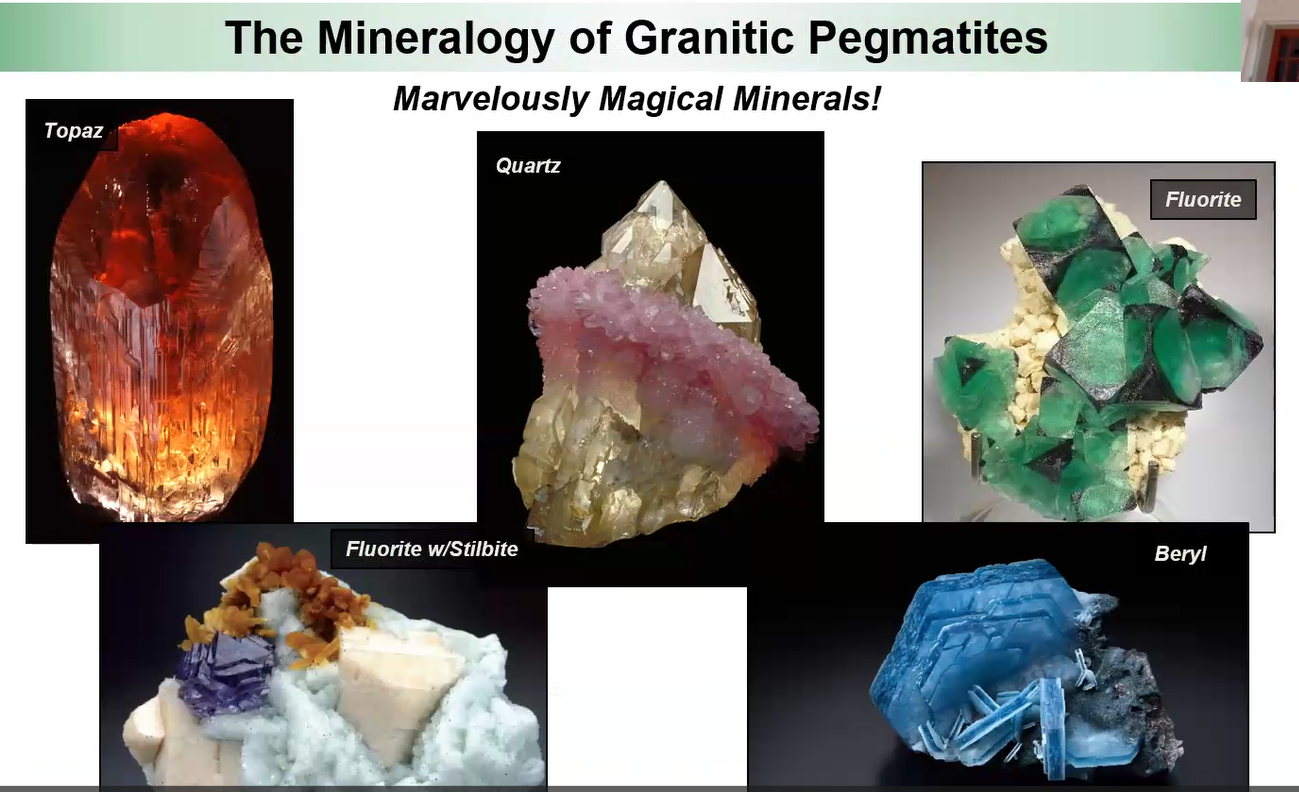
Beyond the elements commonly found in the above gems, such as silicon, oxygen, beryllium, aluminum, and fluorine, the genesis of pegmatites concentrates a very wide collection of additional elements, including the rare earth elements.
“All of the following elements can be found in abundance in pegmatites.”

Despite this vast array of elements found in diverse forms of pegmatite as shown above in the “Pegmatite Periodic Table,” some form of quartz (silicon and oxygen) is abundantly present in the majority of pegmatite crystals. The addition of other elements and the effect of environmental factors such as natural radiation can result in many variations in the crystal color, as shown below.
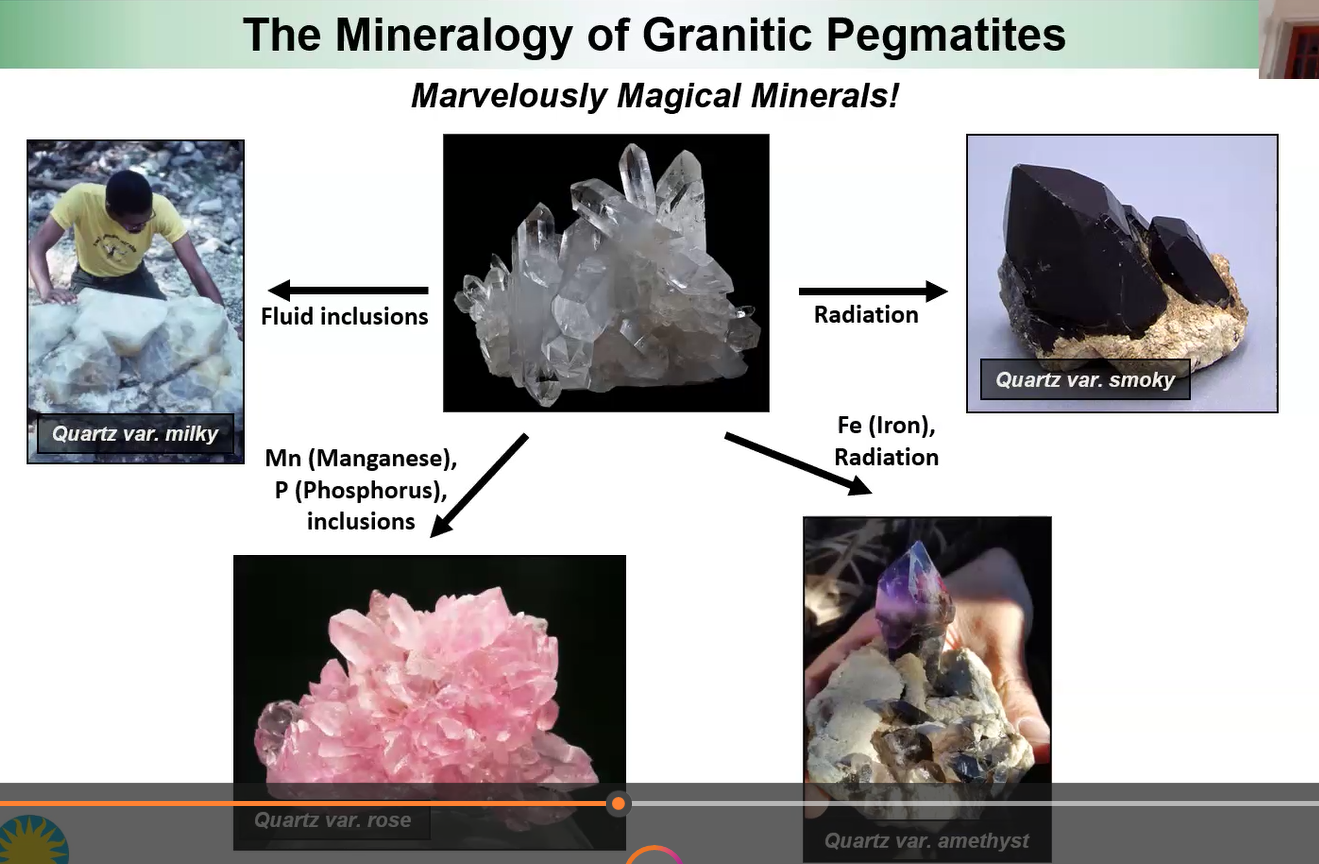
The inclusion of any one particular element during the formation process will change the identity of the growing crystal from start to finish. The addition of lithium, for example, changes what was originally muscovite into lepidolite, as shown below. Later in his presentation, Mike referenced the importance of lithium for today’s high-tech industries, so knowing what to look for in searching for lithium is crucial.
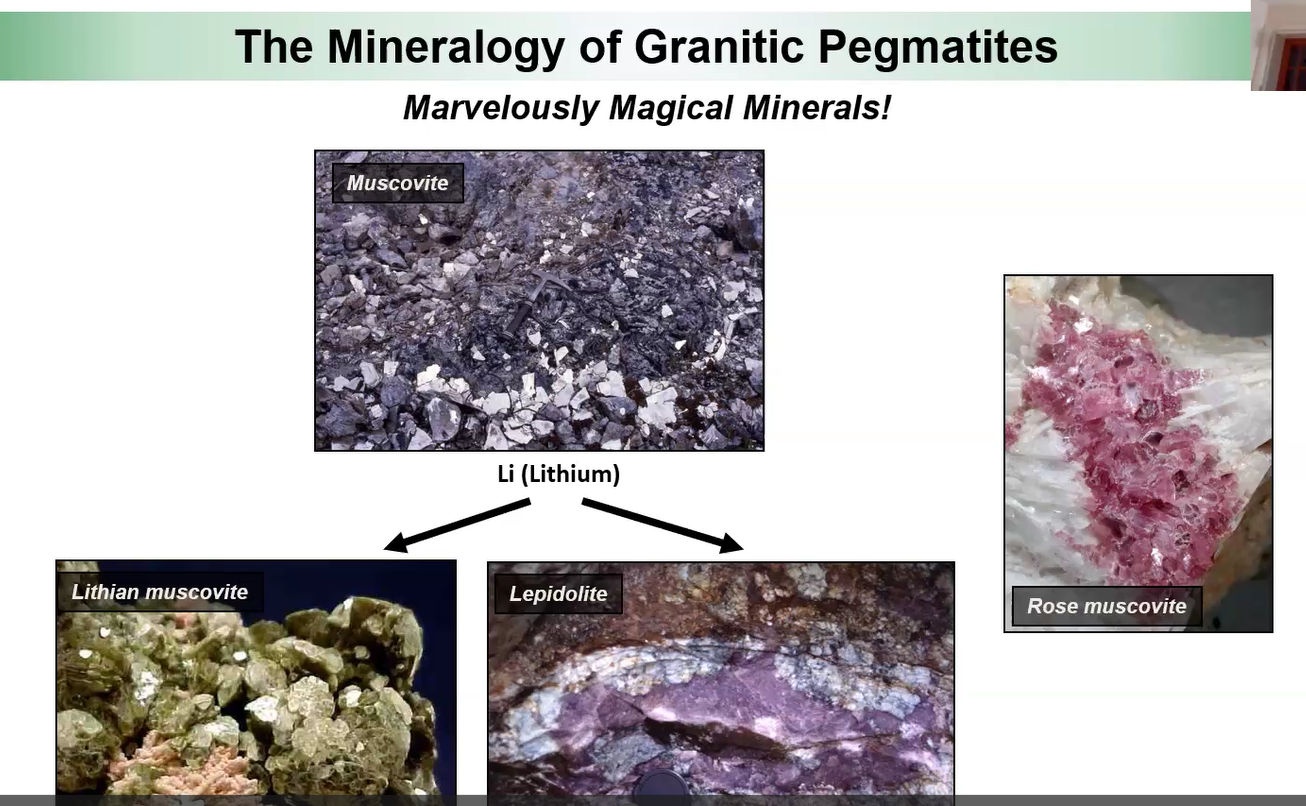
Mike provided numerous examples of how understanding the process of pegmatite crystal formation helps the geological community and mineral collectors understand the genesis of minerals in their collections.
One example among many that Mike explained was how tourmalines can develop from conception to completion, as shown below. On the left, the tourmaline’s base began with the presence of black schorl. As the crystal grew, additional mineral concentrations increased which changed the colors, which is typical of tourmalines. The growth of the specimen on the left ended with a prevalence of manganese which shows as pink.
Yet, on the right, the tourmaline’s growth showed manganese with its pink color added not late, but early during its formation. The final stage saw a concentration of iron, with its dark blue coloration, a hallmark of the famous “blue-cap” tourmalines.
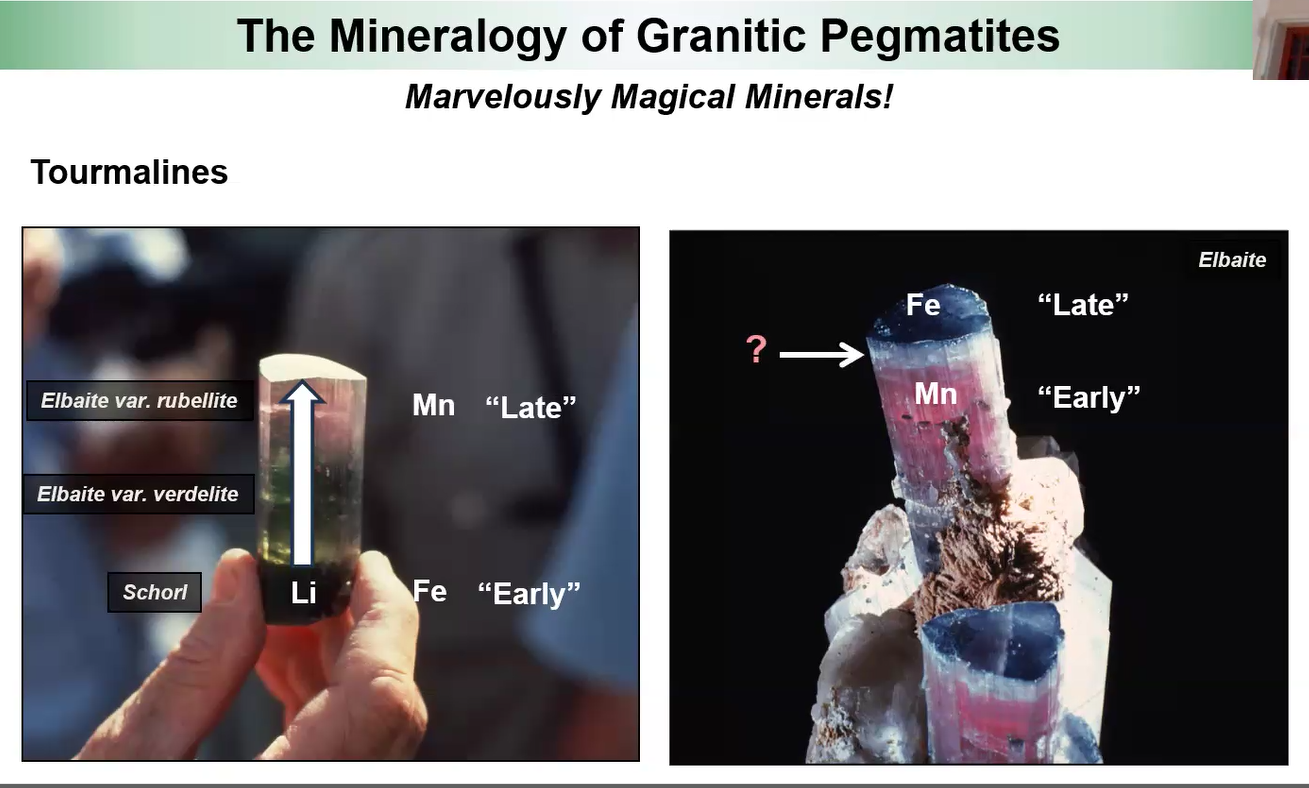
Readers: to gain a systematic overview of how the addition and concentration of selected elements change the identity of the mineral, listen to the video to get Mike’s explanation of the following comprehensive chart.
Hint: the left-hand column of the chart below identifies, toward the top, the simple minerals, and toward the bottom, more complex minerals.
Hint: the minerals in the left column are rich in iron. But as the crystals accumulate more manganese, the identity changes, e.g., from almandine garnet in the left column to the spessartine garnet in the right column. The individual rows identify the shift in the minerals’ elements which change the minerals’ identity, from being dominant in iron to being dominant in manganese.
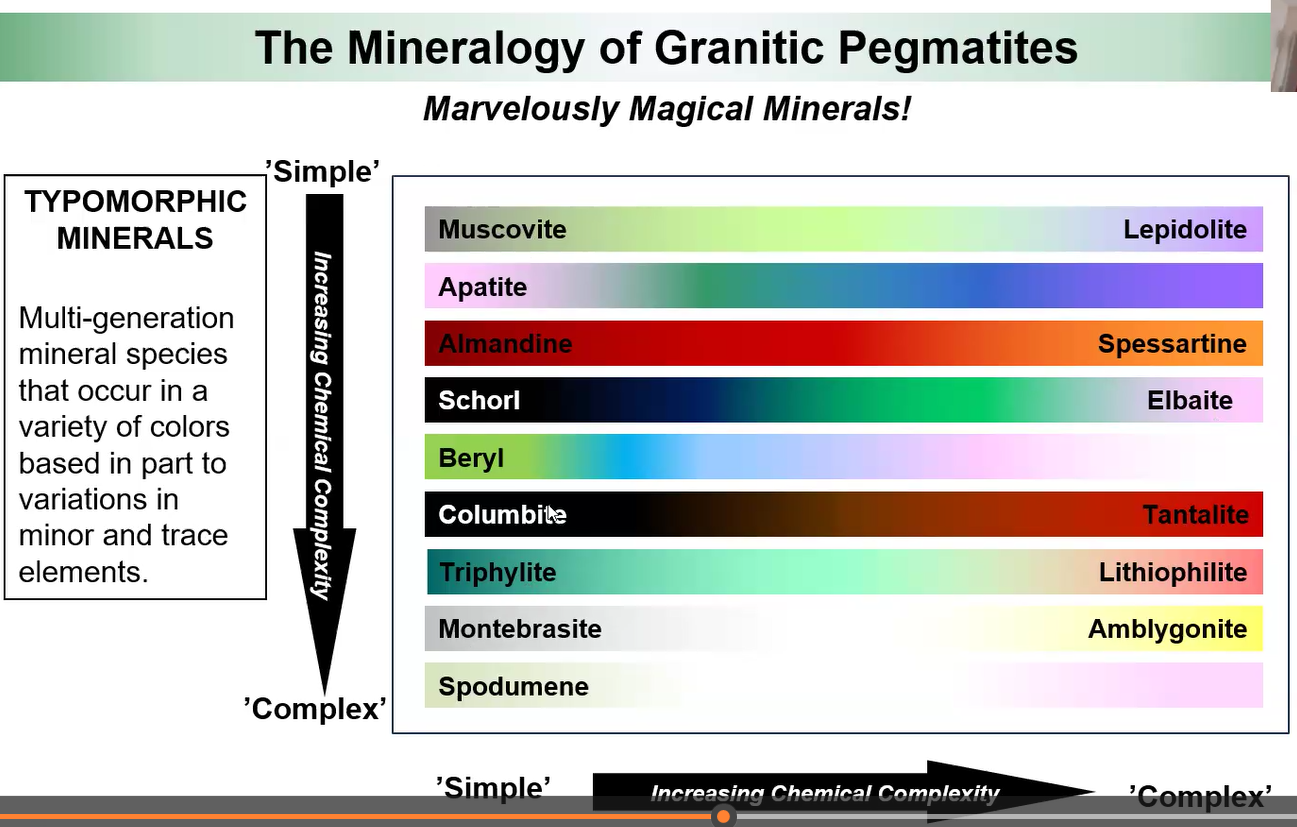
Mike concluded, “So color, if you understand the connection between chemistry and color, you can really start to decipher what’s going on chemically with a particular pegmatite” that you are examining.
As concluding encouragement for readers to view the entire tape of Mike’s presentation (length: 58 minutes), he ends by helping mineral collectors learn:
· Which are the very rare pegmatites and which carbon- based and silicate minerals produce them?
· Which specimen donation to the Smithsonian actually made Mike dance for joy during a convention?
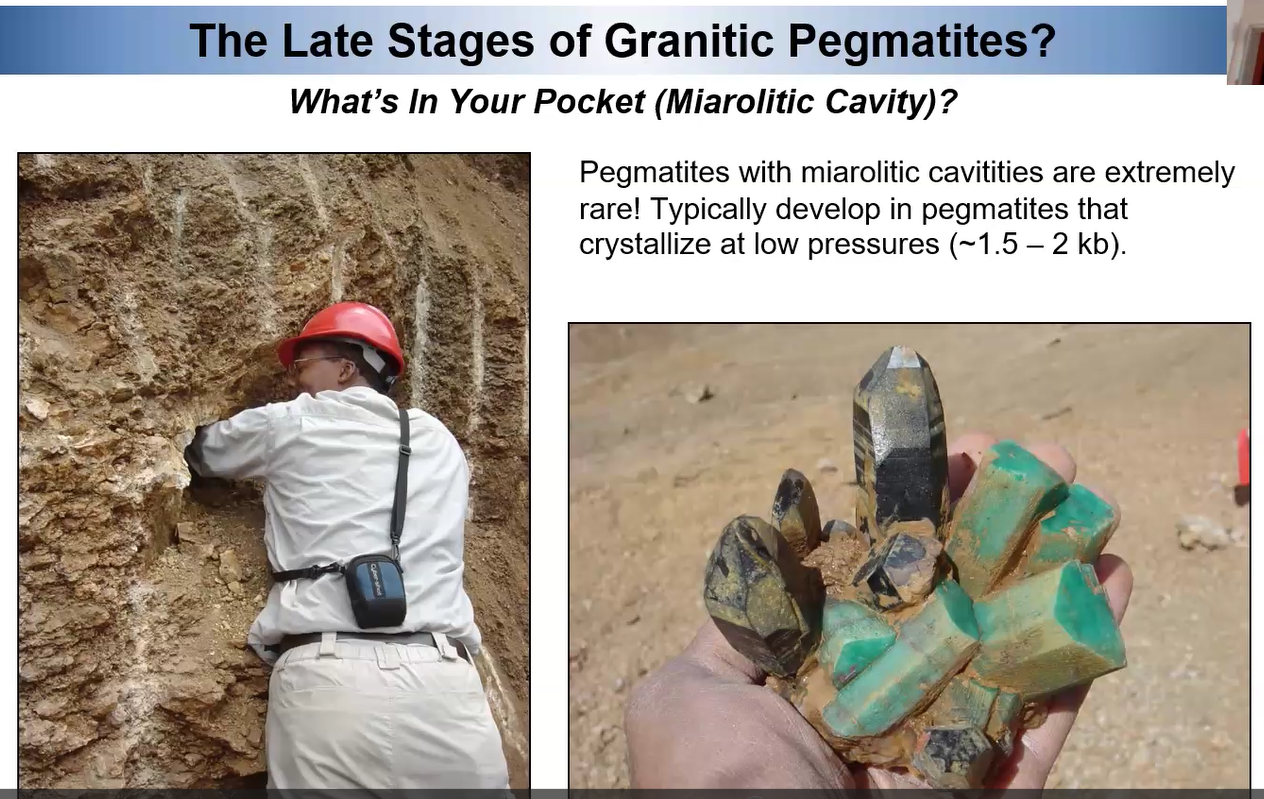
· Why a pocket or vug, which Mike explores above, is so sought after by mineral hunters?
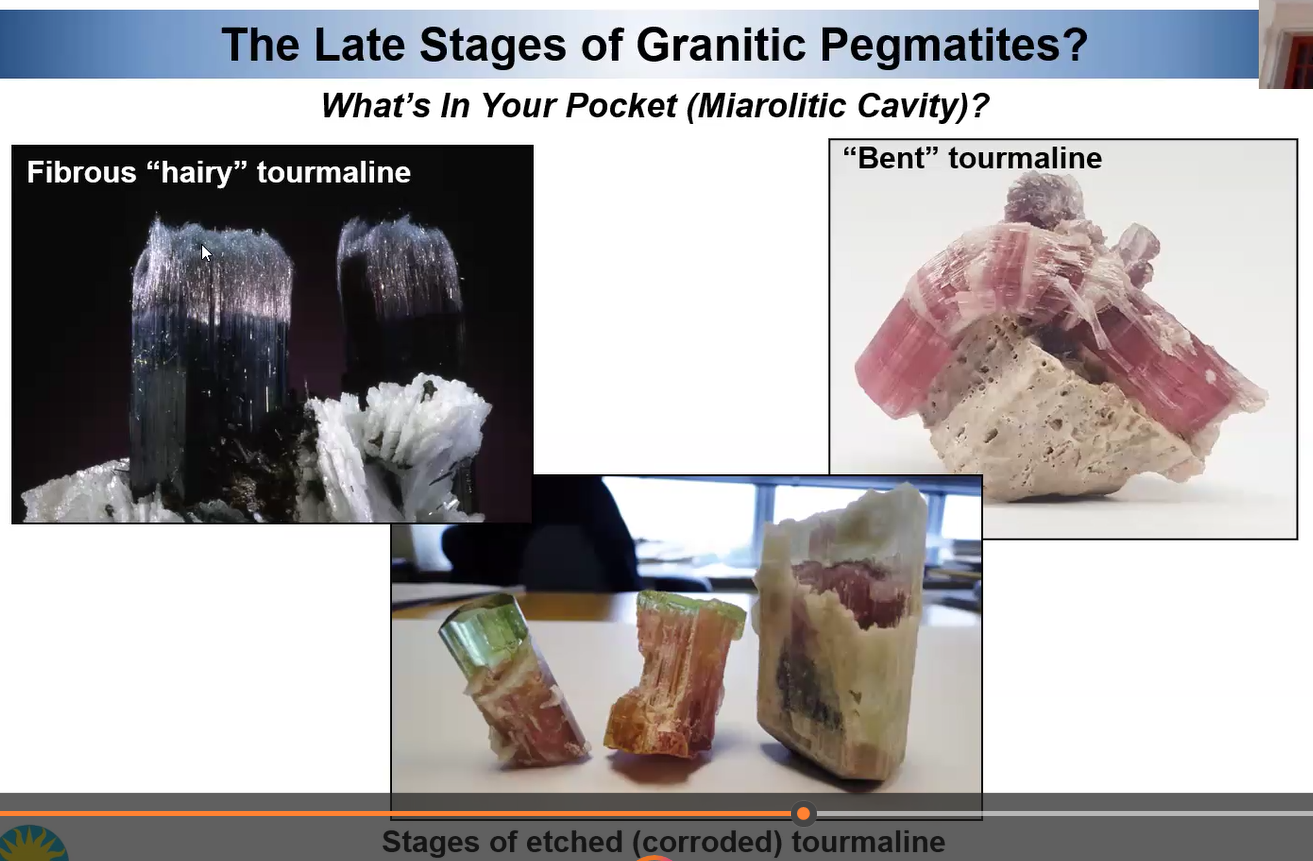
· And why, as the crystals shown above suggest, are pockets often traumatic environments for crystals?
Conclusion
Mike brought his presentation to a close by offering some Moses-like wisdom for his listeners. Curious?
Hint: what are Mike’s ten commandments he urges all mineral enthusiasts to live by?
Readers can view the video of Mike’s presentation in its entirety, along with his response to attendees’ diverse and interesting questions, by going to the video recording of his talk (58 minutes) and Q&A (about 50 minutes) at:
https://www.youtube.com/watch?v=RstQCTZC5JM
MSDC’s president, Kenny Reynolds, thanked Mike for his extraordinary presentation and the audience expressed their appreciation with extensive applause.
